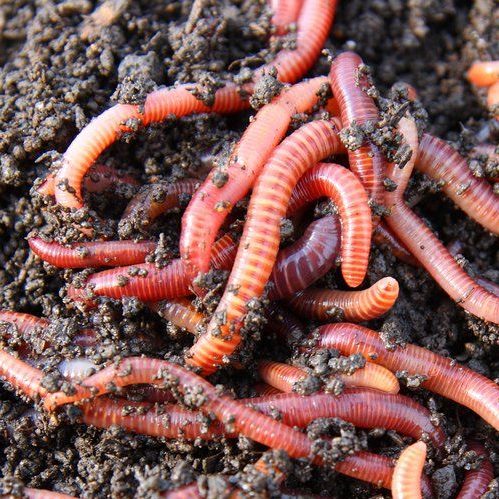Lake Hickory Bait: Your Ultimate Source for Fresh Fishing Gear
Lake Hickory Bait: Your Ultimate Source for Fresh Fishing Gear
Blog Article
Red Wigglers: The Unsung Heroes of Organic Waste Recycling
Red wigglers, or Eisenia fetida, act as crucial agents in the natural waste reusing procedure, transforming disposed of materials into important vermicompost. Their efficient break down of raw material not just improves soil quality but additionally contributes to lasting waste monitoring techniques. As the world increasingly looks for options to combat waste accumulation and boost agricultural productivity, comprehending the function of these worms becomes vital. What mechanisms permit them to prosper in compost settings, and how can they be efficiently made use of in both domestic and commercial settings? Discovering these concerns discloses the wider ramifications of vermicomposting in our ecological landscape.
What Are Red Wigglers?
The amazing strength of red wigglers, clinically called Eisenia fetida, emphasizes their critical function in natural waste recycling. These small, reddish-brown earthworms are typically located in disintegrating organic issue, such as compost stacks and manure stacks. Lake Hickory Bait. Unlike various other earthworm varieties, red wigglers grow in nutrient-rich atmospheres and are extremely reliable at damaging down organic products, making them necessary for vermicomposting

(Red Wiggler Express)Along with their function in waste reduction, red wigglers contribute to dirt health by boosting soil structure and aeration through their tunneling tasks (Lake Hickory Bait). Their presence in composting systems not just enhances decomposition prices however also promotes a lasting approach to squander administration, highlighting their significance in ecological conservation initiatives
Advantages of Composting With Worms
Composting with worms, especially red wigglers, provides countless advantages that enhance both waste administration and dirt health. These worms efficiently damage down organic waste, converting it right into nutrient-rich vermicompost that enhances dirt. This procedure speeds up decomposition, enabling for a quicker recycling of kitchen area scraps and various other organic materials contrasted to typical composting methods.
In addition, the vermicompost produced by red wigglers is bristling with useful microorganisms, which help boost dirt framework, oygenation, and dampness retention. This improves the general health of plants, advertising energetic growth and increased yields in gardens and farming setups. Additionally, making use of worms in composting decreases the production of greenhouse gases, such as methane, adding to a much more lasting waste management system.

How to Start Vermicomposting
Establishing a vermicomposting system is a simple procedure that can generate considerable benefits for both waste management and soil find out here enrichment. To start, choose an ideal container, such as a plastic container or wood box, with ample ventilation holes to make certain correct airflow. The dimensions must ideally be around 2 feet by 3 feet, allowing ample area for the worms to thrive.
Following, prepare bed linen material, which can contain shredded paper, cardboard, or coconut coir. This bedding needs to be moistened to develop a suitable habitat for the worms. Once the bed linens is in area, introduce red wigglers (Eisenia fetida) right into the container, generally around one pound of worms for every square foot of area.
Adhering to the placement of worms, include organic waste, such as vegetables and fruit scraps, coffee premises, and smashed eggshells. Avoid adding dairy, meat, or oils, as these can create odors and draw in bugs. Finally, position the container in a shaded, temperature-controlled area to keep optimum problems for worm activity. With these steps, you will successfully start a vermicomposting system that adds to lasting waste administration and improves your dirt.
Maintaining a Healthy Worm Bin
(Lake Hickory Bait)Maintaining a worm bin flourishing requires regular attention and like make certain the health and wellness of the red wigglers and the performance of the composting process. Correct maintenance starts with keeping track of the wetness degrees; the bin needs to perspire but not saturated. A good guideline is to preserve an uniformity similar to a wrung-out sponge.
Gently blending the bed linen and food scraps every couple of weeks avoids compaction and makes certain that all worms have accessibility to oxygen. Furthermore, it is essential to feed the worms suitably.
Temperature level policy is an additional crucial element. Red wigglers flourish in a variety of 55 to 77 degrees Fahrenheit. If the bin comes to be also warm or chilly, the worms might end up being stressed out - Lake Hickory Bait. Lastly, occasionally look for indications of health, such as worm populace development and the existence of healthy castings. By carefully managing these factors, one can preserve a robust and effective worm bin.
Effect on Sustainable Living
The successful maintenance of a worm container not just profits the wellness of red wigglers yet likewise adds significantly to sustainable living methods. By reusing natural waste, such as kitchen area scraps and backyard particles, red wigglers aid divert considerable amounts of product from landfills. This decrease in waste not just lowers greenhouse gas exhausts however also decreases the ecological worry connected with waste management.
In addition, the castings created by red wigglers work as a nutrient-rich natural fertilizer, boosting dirt wellness and promoting plant development. This natural alternative to chemical fertilizers sustains lasting agriculture and horticulture practices, reducing reliance on artificial inputs that can damage ecosystems. Furthermore, worm composting promotes recognition of waste management, encouraging individuals and communities to adopt more sustainable habits.

Final Thought
In summary, red wigglers function as essential factors to organic waste reusing through their efficient disintegration of natural products. Their ability to create nutrient-rich vermicompost improves dirt wellness and sustains sustainable agricultural practices. By incorporating vermicomposting into waste administration strategies, people and neighborhoods can substantially minimize waste while promoting environmental sustainability. The duty of Eisenia fetida in cultivating healthy and balanced environments underscores the value of these microorganisms in achieving lasting living and boosting soil fertility.
Report this page